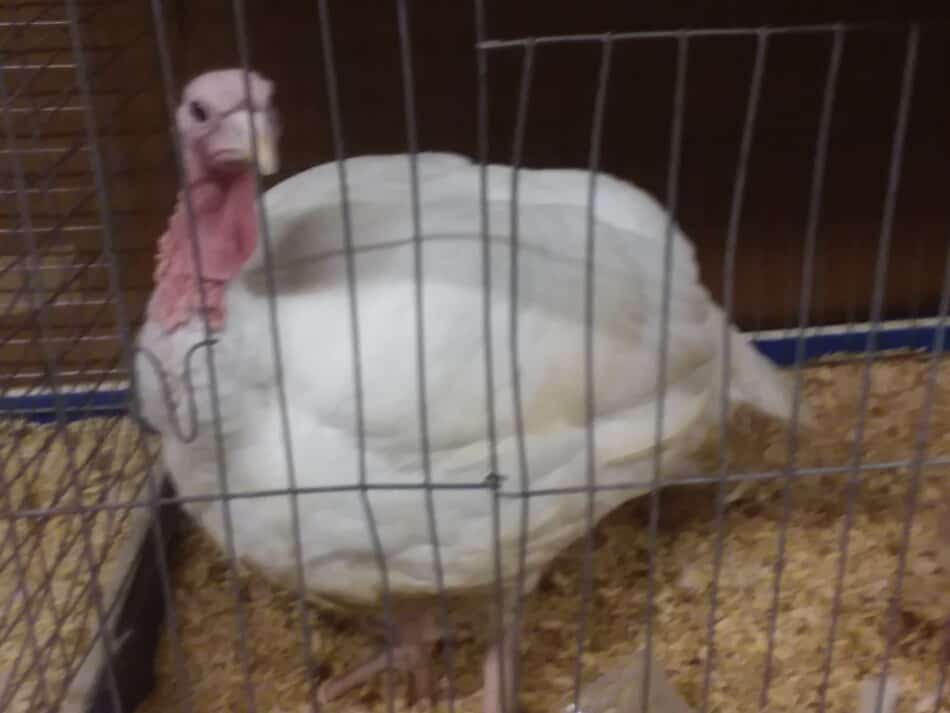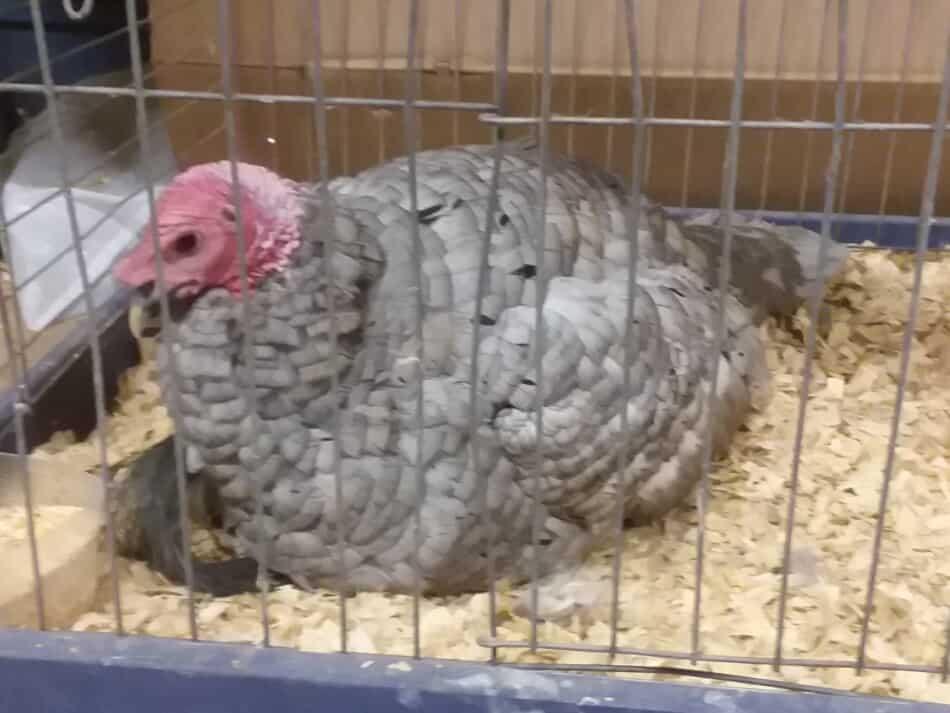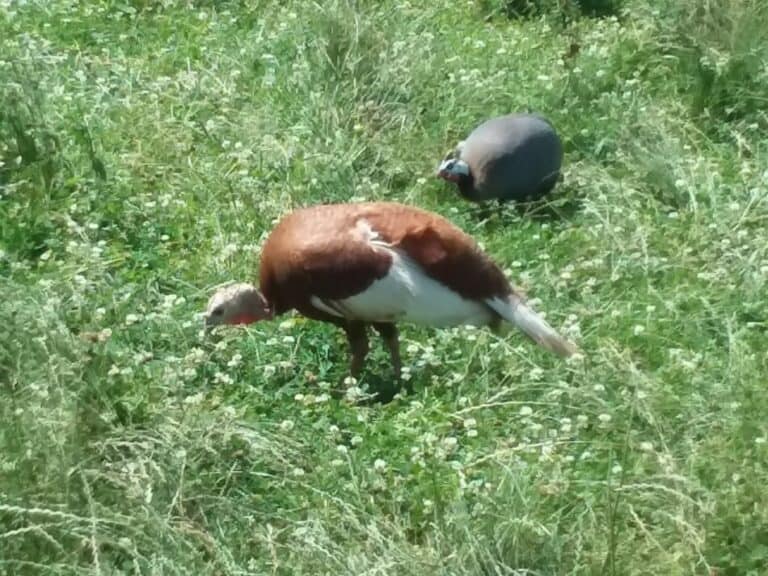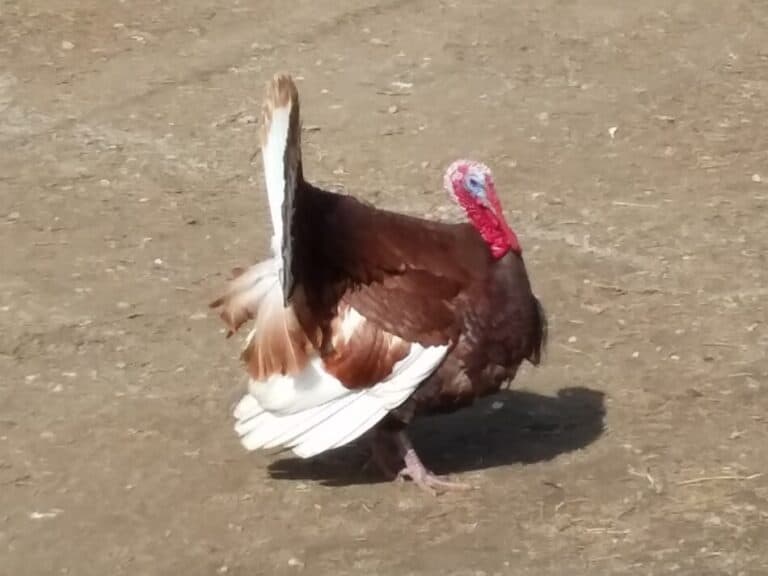What Is The Best Age To Butcher A Turkey?

You’ve decided to raise a few turkeys and plan on serving one up for a stellar holiday dinner. Now you need to know: What is the best age to butcher your turkey?
The best age to butcher a Broad Breasted Turkey is 16-20 weeks, for heritage breed turkeys it’s 24-28 weeks.
Congratulations! Home raised turkey will really up your skills and confidence, not to mention your holiday meals!
We’ll dig into some of the things you need to know to get the well grown turkey you want for the dates you need!
Meat For A Year goes over the combinations of meat animals you can raise to provide your family’s meat supply for the entire year. It also will show you how to calculate the meat needed for your family.
Turkeys are processed at 16 weeks
Most of the meat turkeys that you would be growing for meat are Broad Breasted Whites or Bronze, since these are buy far the fastest growing turkeys available.
The choice to process at 16 weeks up to 20 weeks (or even longer if you want a massive bird), is based on how big of a bird you want to cook and whether the turkey is male or female.
Here is part of a chart from Penn State Extension on Small Flock Turkey Production, showing the weight of Broad Breasted White turkeys at 16-20 weeks of age.
| Age of turkey in weeks | Toms-pounds live weight | Hens-pounds live weight |
| 16 | 25.25 | 18.65 |
| 17 | 28.03 | 20.15 |
| 18 | 32.23 | 21.57 |
| 19 | 34.22 | 22.90 |
| 20 | 36.32 | 24.14 |
Of course, you can raise a heritage breed for meat as long as you are okay with a smaller carcass that will take longer to finish.
Broad breasted turkeys have the most meat

If you are looking for growth, broad breasted turkeys are your top choice.
Nothing else will compare in terms of the amount of meat you’ll get for the money you put into the poult and the feed.
If you are raising turkeys just for a great meat animal, go for the broad breasted birds. They will give you the biggest bang for your buck.
Heritage turkeys have the most flavor
If your primary goal with raising turkeys is flavor, heritage turkeys are your answer!
Wondering what breed of turkey would suit you the best? Read my article 10 Breeds Of Turkeys For Raising Your Own Meat!
These guys are slower growing than the broad breasted turkeys and more of an active bird to keep around.
The trade off for your extra time and effort is that heritage turkeys are wonderful to eat!
I have to admit, I was never a “turkey person” as far as loving to eat turkey. For me, turkey meat was fine but not anything to get too excited about.
Until we raised and butchered some heritage breed birds. Wow the taste is amazing, not even in the same world as the store bought turkey!
I am now a fan of turkey and advocate them to anyone who is looking for a great bird to raise for meat!
Pen off turkeys the night before processing
Ideally, your turkeys would be held off of feed the night before processing.
Take out their feeder and pen them off in a secure area so you’ll have an easy time of catching them in the morning. You are taking out the feeder in case the birds get out of the holding pen!
The whole reason to pen the birds off of feed is to keep them from eating extra feed that will make the digestive tract full and a bit harder to work around during butchering.
You can process the turkey at anytime, even if the bird has just eaten feed.
Having a cleaned out digestive tract, or at least a less full digestive tract makes butchering less messy.
If you are unable to pen them up or they happen to get out, you’re still okay if you butcher them early in the morning.
There will be some feed and grass in the digestive system, but not as much as if you let them fill up for the day and then decide to process them.
The difference in turkeys is trait selection

How is it that these two types of turkeys are so different in results? That’s easy, genetic selection for specific traits over many generations.
The Broad Breasted turkeys are the king of commercial turkey production, think of them as the broiler of the turkey world.
Broad Breasted turkeys have been heavily selected for the traits that make them stellar confinement turkeys, fast growth, tons of breast meat and white feathers.
While all of these traits are impressive, they come at a cost of Broad Breasted turkeys needing more exacting feed and not being able to naturally breed.
The heritage turkeys, on the other hand, have been selected for a different set of traits, giving you markedly different results.
Heritage turkeys have not been selected to perform in intensive raising conditions, they have been selected for more grazing ability and color and have kept the ability to reproduce naturally.
Heritage vs Broad Breasted turkey carcasses
The broad breasted turkey carcass is going to be impressive. Wide and extremely well filled out, especially across the breast.
This will be the case with hens as well as toms, both have the same expansive breast meat structure. The whole body of the hen will be smaller than the toms, but both make impressive dinners!
A heritage turkey carcass is going to be smaller and probably have a bit of the keel (breast bone) sticking up over the top of the breast meat. This is normal.
You’ll also notice that the heritage turkey carcass overall is smaller than the carcasses of the broad breasted turkeys, also normal.
You have options on turkey processing ages
If you are wanting a bigger bird to raise for a specific date, like Thanksgiving, you can start the birds earlier in the year. Even early enough that you put the bird in the freezer then thaw it out when needed.
As you can see from the chart above, one of the easiest ways to get a variety of finishing sizes for your turkeys is to get a mix of males and females. This mix will automatically give you some wiggle room in your processing dates.
The other option you may want is a bigger bird. These broad breasted turkeys will keep on growing until processing! You can get some massive turkeys if you do not process them until after 20 weeks.
For example, our county fair is in mid September and market turkeys are a popular Junior Fair project. These birds are routinely weighing 50+ pounds and looking good!
Broad breasted turkeys 80% meat yield
Turkeys actually have a very high dressing percentage, meaning you keep a large portion of the live weight of the bird in the oven ready meat.
Check out this Carcass Dressing Percentage article from Michigan State University for the specifics on dressing percentages. It lists turkey dressing percentage as 77-81% with 79% as an average. I used 80% for easy math.
Take 80% of the target weight of your turkeys and see what you are going to end up with in your oven.
The reason you are doing the math is here to decide what size of a bird you need to have at processing.
| Live weight of turkey | Broad Breasted White (broad breasted turkeys only) | Dressed weight of turkey |
| 18 pounds | Hen @16 weeks | 14.4 |
| 20 pounds | Hen @ 17 weeks | 16 |
| 22 pounds | Hen @ 19 weeks | 17.6 |
| 24 pounds | Hen @ 20 weeks | 19.2 |
| 26 pounds | Tom @ 16 weeks | 20.8 |
| 28 pounds | Tom @ 17 weeks | 22.4 |
| 30 pounds | 24 | |
| 32 pounds | 25.6 | |
| 34 pounds | Tom @ 19 weeks | 27.2 |
| 36 pounds | Tom @ 20 weeks | 28.8 |
| 38 pounds | Tom @ 21 weeks | 30.4 |
| 40 pounds | Tom @ 22 weeks | 32 |
The chart above is going to apply to the broad breasted turkeys, mostly due to the live weight of the turkey.
Your heritage breed turkeys are going to be on the smaller end of things but the math is still the same.
Heritage turkeys 75% meat yield
To figure the dressing weight of a heritage breed turkey use 75% of live weight.
| Live weight of heritage turkey | Heritage turkey (not broad breasted) | Dressed weight of heritage turkey |
| 10 pounds | 7.5 | |
| 12 pounds | Hens @ 16 weeks | 9 |
| 16 pounds | 12 | |
| 18 pounds | 13.5 | |
| 19 pounds | Toms @ 18 weeks | 14.25 |
| 20 pounds | 15 |
Since heritage turkeys are not raised commercially to any scale, there is much less information available on time to finishing and the corresponding weights.
Here is the article that has the most information that I was able to find, Heritage turkey production research at Penn State.
Additionally, there are quite a variety in heritage turkey breeds and raising methods meaning the results are going to vary significantly from breed to breed and from person to person.
Get broad breasted turkey poults in mid July
For a Thanksgiving ready turkey, get your broad breasted poults in mid July. This will give you a 16 week old turkey a week to 10 days before Thanksgiving.
If you have a tom, he will be 26 pounds live weight and 20.8 pounds dressed at 16 weeks. If you are raising a hen, she will be 18 live and 14.4 dressed.
If you are thinking of a bigger bird for the holiday, get your poults in early July to late June.
May I offer a bit of advice? Be sure you do some math and consider some basics like how much meat do we want per bird?
An especially critical question: Will the carcass fit into the oven?
Get heritage turkey poults in mid May
My best guess for the dates to get your heritage breed turkey poults is mid May. This will give you a well grown turkey 26 week old turkey to process a week to 10 days before Thanksgiving.
If you are hoping for a bigger bird, consider ordering your poults to arrive in late April, which will give you a 28 week old turkey in time to process for Thanksgiving.
The reason I only have a guess and not too many specifics, is that these birds vary quite a bit.
Heritage turkeys vary in mature weights
Some of the heritage turkeys grow to 30 pounds (Chocolate toms) but do not have a market weight listed.
Others toms are at 16-23 pounds market weight (Royal Palms and Bourbon Reds) with a mature weight of 22-33.
The other “catch” with the heritage breed turkeys is that they are available as straight run only, meaning you’ll get a mix of male and female birds.
So, what’s the catch, you ask? The hens in heritage breed turkeys will be smaller than the toms, sometimes significantly so.
Do the math on your chosen breed for the best growers, toms, and the slower growers, the hens, to make sure your turkeys are the size you need them to be.
Here’s a link to Meyer Hatchery’s turkey page. Click around and see the variety of turkeys and their characteristic differences.
Best time to get non holiday turkeys
Even if you are wanting to raise some turkeys but really don’t need them for a specific date, you’ll still want to stick to these dates as much as you can, especially for heritage turkeys.
The reason for this is that turkeys are a longer growing poultry project than most other meat birds, so you need the good weather of those turkeys to get to full size.
Of course, you can raise turkeys anytime of the year that they are available from the hatchery, as long as you have a place to keep them warm and safe.
If you are going to raise the broad breasted turkeys, you’ll have more options with the dates, since you will only have them for 4-5 months.



